Learn how to make traditional South Indian-style raw mango pickle, also known as Manga Urugai. This vegan, preservative-free Indian cut mango pickle is bursting with bold, tangy, and spicy flavors-and it pairs beautifully with everyday Indian meals like curd rice, khichdi, and paratha.

🥭 What Is Manga Urugai (Indian Mango Pickle)
In Tamil, "Manga" means mango, and "Urugai" means pickle. South Indian Mango Pickle, is a spicy, tangy, and flavorful condiment made by preserving raw green mangoes in aromatic Indian spices, and cold-pressed gingelly oil (Indian sesame oil). This traditional South Indian mango pickle recipe is typically prepared during the summer months when mangoes are in season and the strong sunlight naturally aids in natural preservation.
Each South Indian household has its own cherished method of making mango pickle, often passed down through generations. Whether called Manga Urugai in Tamil, Aam ka Achaar in Hindi, or simply Indian raw mango pickle, it remains a beloved staple in Indian kitchens.
With the easy availability of raw mangoes in Indian grocery stores across the U.S. and worldwide, you can now enjoy this homemade vegan mango pickle all year round. This Indian Green Mango Pickle is also served in restaurants and in the traditional Indian Thali.
Traditional Method of Making South Indian Mango Pickle
In many South Indian households, the art of making traditional green mango pickle is a cherished ritual passed down through generations. For example, my grandmother followed a time-honored method: she would buy manga in bulk, then chop and coat them with salt. She would then leave them to sun-dry for several days. Once slightly dehydrated, the mangoes were combined with a homemade blend of Indian pickle spices and stored in large Barni jars (traditional ceramic pickle jars) or sterilized glass containers.
In this process of pickle making, the ingredients ferment as the pickle ages. This slow, natural process not only preserves the manga urugai for months but also deepens its bold, tangy, and spicy flavor. These sun-cured Indian pickles can be enjoyed throughout the year, adding a zesty kick to our daily meals.
Why Make Mango Pickle at Home
Quality Control: Homemade manga urugai is free from preservatives, artificial colors, and excess oil commonly found in store-bought versions.
Customization: Adjust spice levels, sourness, and saltiness to suit your taste.
Cultural Connection: Engaging in the traditional process of sun-drying and mixing spices when making Indian pickled mango, fosters a sensory and cultural bond to your roots. By making Mango Pickle at home, you're preserving not just raw mangoes-but a rich culinary heritage.
Enhanced Flavor: Homemade Indian pickles often have a more robust flavor due to the use of cold-pressed oils and freshly ground spices.
Making pickles at home does require time and patience but the end result is worth the effort. There are countless variations of Indian mango pickle, with each household adding its own unique touch. This achar recipe is a treasured family heirloom, lovingly passed down from my grandmother.
What does An Indian Pickle Taste Like
Indian pickles (achaar) are intensely flavorful, offering a bold mix of spicy, tangy, sour, salty, and sometimes sweet tastes. The exact flavor varies by region and preparation method, but all Indian pickles are designed to add complexity to a meal. Typically served in small portions, they enhance the flavor of rice, flatbreads, or curries.
Beyond flavor, pickling in India is an ancient culinary tradition rooted in Hindu spiritual practice. According to traditional beliefs, sun-drying and air-curing-key steps in making pickles-are among the few sacred ways to make raw food edible.
Indian Pickles vs American Pickles
Indian pickles, or achar, differ significantly from American pickles in ingredients, flavor, and preparation:
Base: Indian pickles are oil-based, using cold-pressed oils like gingelly (sesame) oil or mustard oil, while American pickles are vinegar-based.
Flavor Profile: Indian pickles offer a complex mix of spicy, tangy, salty, and sometimes sweet flavors. American pickles are typically crisp, briny, and tangy, with dill being a popular seasoning.
Preparation: Indian pickles often involve fermentation and sun-curing, whereas American pickles are usually quick-pickled and refrigerated.
Why Make It
- Traditional South Indian-style Mango Pickle recipe
- Naturally vegan
- Gluten-free when made with GF asafoetida (hing)
- Homemade mango pickle recipe without any preservatives or artificial colors
- Long shelf life when stored properly
- No-cook easy recipe
- Bursting with bold, tangy, spicy flavors
- Pairs perfectly with everyday Indian dishes
🧾 Ingredients Needed

Raw Mango - Use firm, unripe green mangoes that are sour and tart in flavor. Avoid sweet or semi-ripe mangoes, as they alter the traditional taste of the pickle. Raw mangoes are typically available at Indian grocery stores or local ethnic markets-and if you're lucky, maybe even growing in a neighbor's backyard!
Note - I have used raw mangoes, you can also use whole baby mangoes to make Manga Urugai. They are called Vadu Manga in Tamil. Another variation to homemade Mango pickle, is to grate the raw mangoes and make Manga Thokku.
Spices - The bold flavor of South Indian mango pickle comes from a powerful mix of spices - mustard powder, methi seeds powder, salt, red chilly powder, turmeric powder, and gluten-free asafoetida or regular hing. These spices not only add flavor but also act as natural preservatives. You can also add Kashmiri red chilly powder for color.
For convenience, you can also use ready-made Indian pickle masala or spice blends available at Indian stores instead of mixing individual spices. You can use achar masala to make Achari Dahi Bhindi.
Oil - Since this is a Tamil-style pickle recipe, always use cold-pressed gingelly oil (also known as Indian sesame oil) for pickling. It's the best oil for South Indian pickles, as it enhances flavor, adds depth, and naturally preserves the pickle for longer shelf life. North Indians use mustard oil. You can use that too, the flavors will not be South Indian though.
How To Make It 🔪

- Wash and dry the raw mangoes thoroughly to remove any surface dirt or moisture-this step is crucial to prevent spoilage. Cut them into ½-inch cubes using a sharp knife, keeping the skin on for texture and better preservation.💡 Tip: Don't discard the pulp around the seed-it can be used to make *Instant Mango Thalar Pickle (Manga Thalar Oorugai). Discard the innermost seed.
- Transfer the chopped mango pieces to a large, clean, and dry mixing bowl that's preferably glass or stainless steel.
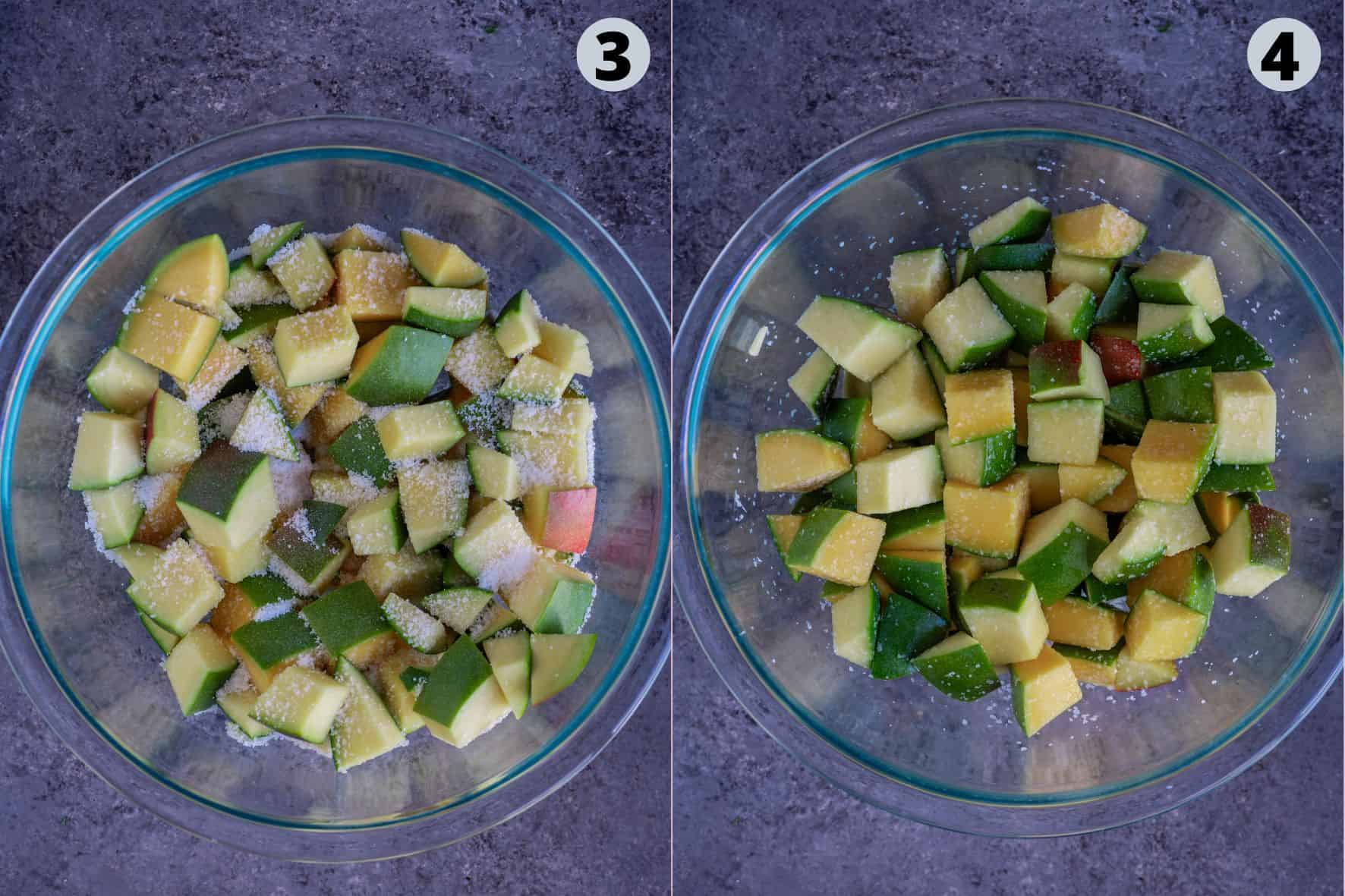
- Sprinkle salt generously over the chopped raw mango pieces. 💡 Tip: For the most authentic flavor and longer shelf life, use rock salt or sea salt when making this traditional South Indian mango pickle.
- Toss well to ensure every piece is evenly coated-this step helps draw out moisture, reduce the sourness, and acts as a natural preservative.
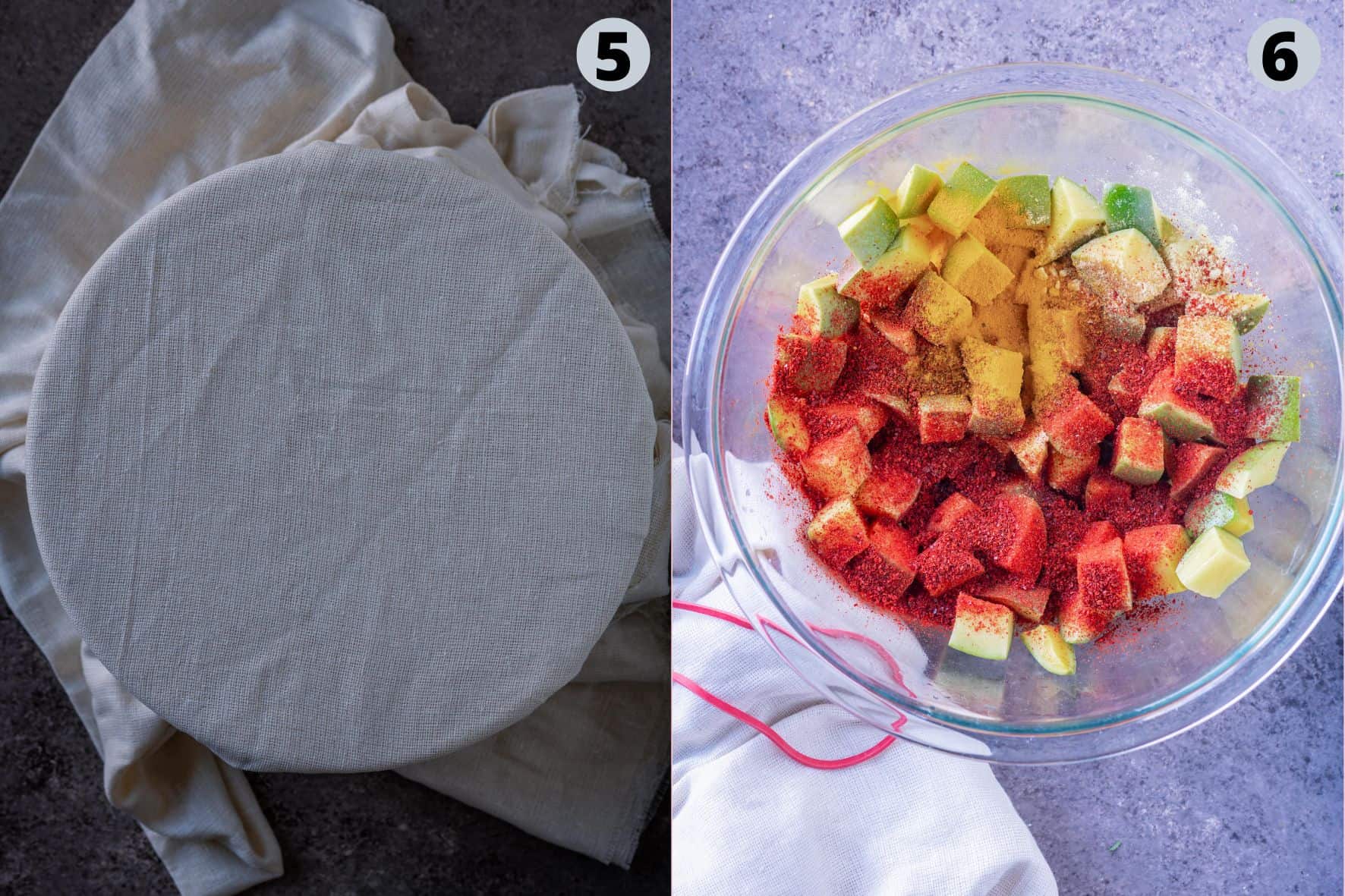
- Cover the salted mango pieces with a clean muslin cloth and secure it with a rubber band. Place the bowl on your kitchen counter (away from direct sunlight) and let it sit at room temperature for 3 to 5 days. 👉 Every day, uncover the bowl, stir the mango pieces well, and cover it again. This daily mixing ensures even fermentation and prevents spoilage.
- After 3 to 5 days, when the mango softens slightly and releases its natural juices, add red chilly powder, mustard powder, methi powder, and turmeric powder. These spices infuse bold flavor and act as natural preservatives.

- Heat cold-pressed gingelly oil (Indian sesame oil) in a small pan over medium heat. Once hot, add hing (asafoetida) and let it sizzle. Bring the oil to a gentle boil, then immediately turn off the heat.
- Carefully pour the hot spiced oil over the mango and spice mixture. The sizzling oil helps release the aromas of the spices and enhances the flavor of the pickle.
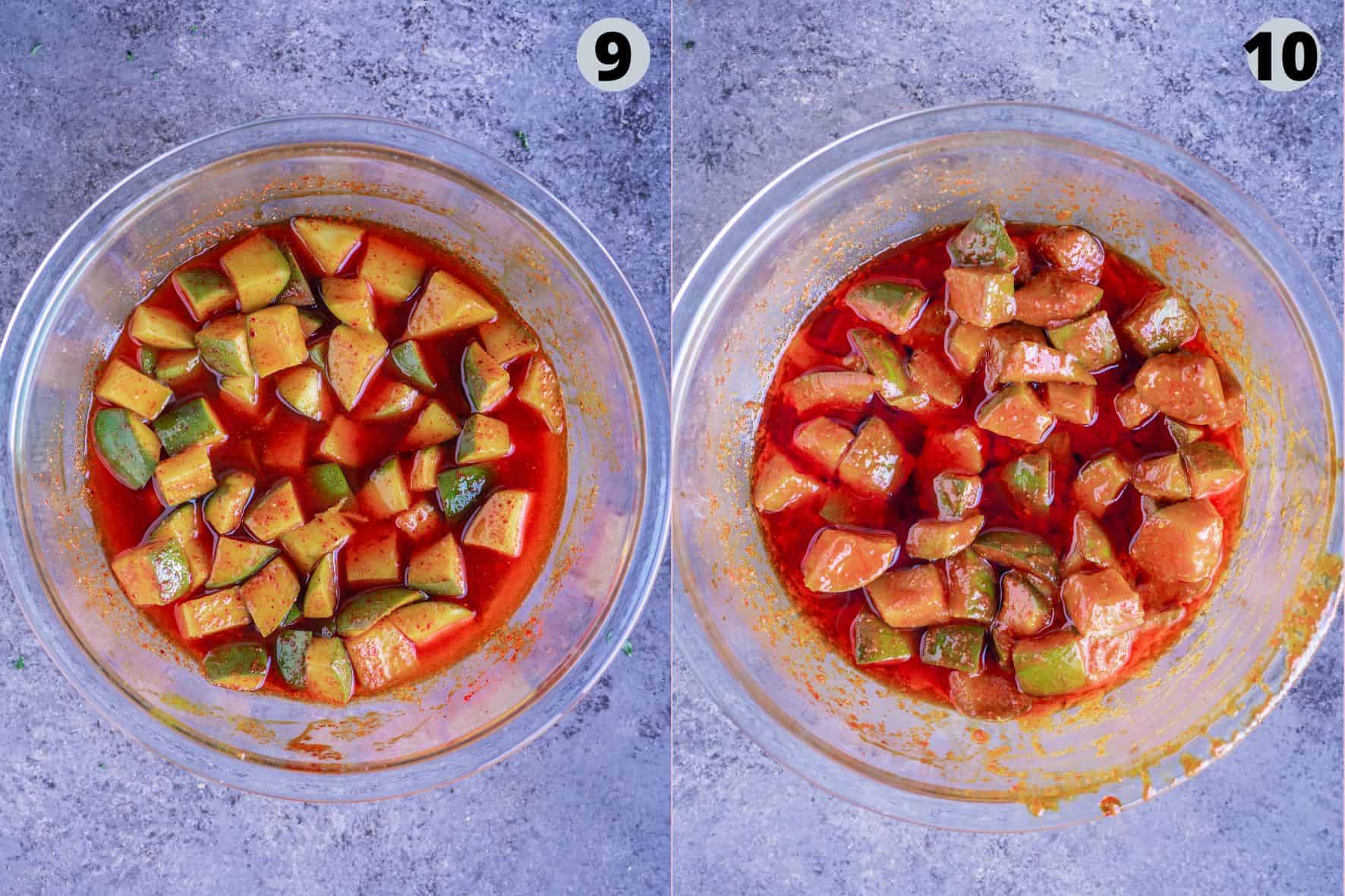
- Mix the mango pieces thoroughly to coat them evenly with the hot oil and pickle masala. Allow the mixture to cool completely at room temperature. Once cooled, cover the bowl and leave it on the counter (not in the refrigerator) for 4-5 days. Stir it once daily to bring the mangoes settled in the bottom to the top. This resting period helps the raw mango pieces absorb the bold, tangy, and spicy flavors, resulting in a well-balanced and flavorful pickle. Note - Depending upon the weather where you live, pickling could take less or more days.
- After 4-5 days, taste a piece-it should be soft, tangy, and bursting with flavor. Add more gingelly oil if needed. If it is slightly bitter to taste, keep it for 1-2 days more. At this stage, transfer the pickle to a clean, dry, and sterilized glass or ceramic pickle jar. Store it in the refrigerator to extend shelf life.
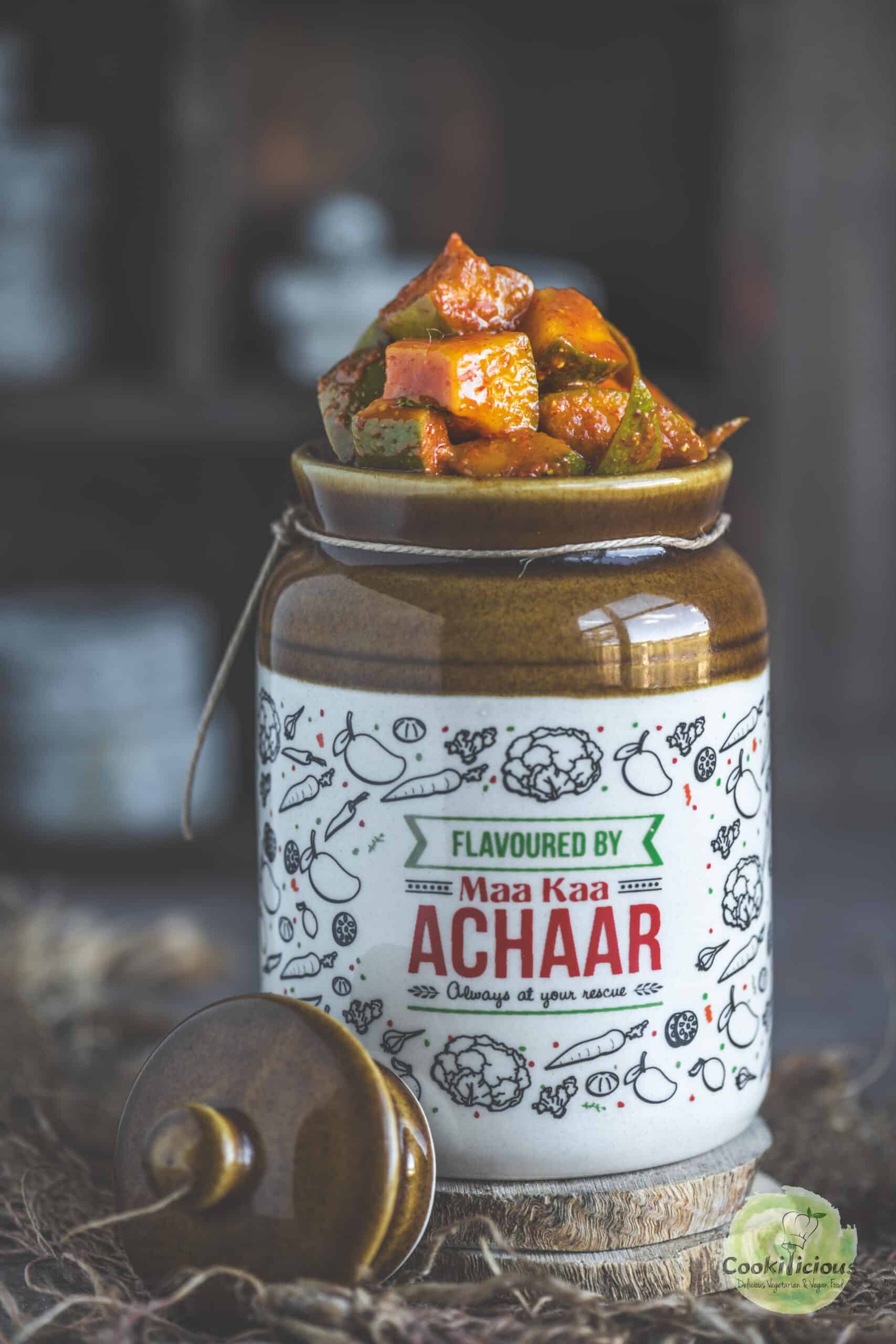
🍽 Serving Suggestions
Unlike liquid condiments that can be poured or drizzled, Indian mango pickle is meant to be enjoyed in small portions. Serve 1-2 teaspoons alongside your meal to enhance the flavor of rice, flatbreads, or curries. The right way to eat Mango Achar is by cutting off a small piece of the pickle and combining it with each bite of rice or roti-it adds an instant burst of tangy, spicy flavor.
There's no need to heat the pickle before serving. It's best to eat pickle in moderation as it has a lot of salt and oil! Always use a clean, dry spoon to scoop out the desired amount. This helps maintain the pickle's freshness and prevents spoilage.
Enjoy this Cut Mango Pickle with Curd Rice, roti, bhakhri, poori, Dal Rice, Lemon Rice, Coconut Rice, Rasam Rice, Paruppu Sevai, Ammini Kozhukattai, Mor Kuzhambu, Paratha, Ven Pongal, Upma, Millet Khichdi, or Masala Dal Khichdi. You can also use mango achar as a salad dressing, a topping on wraps, sandwich spreads, or mix it with plain steamed rice.
💭 Priya's Recipe Tips
Keep the mango skin on when chopping-the skin adds texture and helps the pieces hold their shape during the pickling process. Cut them into uniform ½-inch cubes for optimal flavor absorption and ease of mixing. When making achar masala, dry roast mustard seeds, and fenugreek seeds. Then grind them to make a coarse powder. Use this in the Mango Achar recipe. You can also air-dry the other spice mixes for a couple of hours to remove any excess moisture from them. For convenience, you can use ready-made Indian pickle masala or spice blends available at Indian stores instead of adding them individually.
FAQs 📖
The best mangoes for making homemade Manga Urugai are firm, unripe green mangoes that are naturally sour. These raw mangoes give the pickle its signature tangy flavor and crisp texture. Avoid using sweet or fully ripe mangoes, as they alter the taste and consistency of the pickle.
If you only have slightly yellow or semi-ripe mangoes on hand, you can still use them, but the resulting pickle will be milder and slightly sweet. If your raw mangoes are too tart, simply adjust the salt to balance the flavor.
If you happen to have semi-ripe mangoes, consider using them in other delicious recipes like Mango Avocado Smoothie or Mango Peach Creamsicles.
Always store manga urugai in a clean, dry, sterilized ceramic or glass jar to increase shelf life. Do not store it in plastic containers. Traditional vegan mango pickle can be stored at room temperature for up to 2 months. Always use a dry spoon when handling the pickle.
Also, mix it gently every few days to ensure the achar masala coats the mangoes evenly. Press it down so that there's always a layer of oil on top. Do not leave the spoon inside. The pickle will get spoiled. Refrigeration extends shelf life, especially in humid climates. If stored in the fridge, aam ka achar will stay good for a year.
Want a quick version? Try this easy Instant Mango Pickle recipe (Manga Thalar Oorugai), often served at South Indian weddings (Kalyana Oorugai). At home, we use the leftover small pieces around the mango seed to make it. Chop the raw mango into very small pieces. Add salt.
Do a tempering of mustard seeds, hing, and red chilly powder. Use gingelly oil to do the tadka. Pour this over the cut mango. Mix and store in a clean dry container with lid. This raw mango pickle has a short shelf life. Consume it within a week.
Gingelly oil (Indian sesame oil) is ideal. It enhances flavor and acts as a natural preservative. You can find it in all Indian grocery stores and on Amazon. North Indians use mustard oil when making Mango Achar. Neutral vegetable oil like avocado oil or peanut oil can also be used.
Asian sesame oil can be used as a substitute for gingelly oil, as both are made from sesame seeds and share a nutty aroma. However, toasted Asian sesame oil has a stronger, more intense flavor, while gingelly oil is milder and more versatile for South Indian cooking and pickling.
Yes! While traditional raw mango pickle recipes involve sun-drying, you can skip this step by using the instant method or ensuring the mangoes are moisture-free and stored in a dry place.
While raw mango is the most iconic base for Indian pickle, a wide variety of fruits and vegetables can be used to make flavorful homemade achar. Popular options include cauliflower, carrots, radish, turnips, butternut squash, green chilies, lemon, garlic, ginger, pearl onions, and turmeric root. You can also mix different vegetables and make mixed vegetable pickle.
Some regional variations also use ingredients like tomatoes, bitter gourd (karela), ivy gourd (tindora), hog plum (amba), jackfruit, or even raw papaya.
Fruits like apples, pear, gooseberries (amla), and pineapple can also be used to make achar. Get creative.
Each ingredient brings its own unique flavor and texture, and is typically paired with region-specific spices and oils to enhance taste and shelf life. This diversity makes Indian achaar not just a condiment but a deeply rooted cultural expression of seasonal produce and local culinary traditions.
Summer Mango Recipes

⭐️ Subscribe to the Cookilicious Newsletter and receive new recipes straight to your inbox! You'll receive my FREE Vegan Beginner's guide as a gift. Ready to elevate your cooking game? Purchase my Cookbook - The Essential Vegan Indian Cookbook today!
Recipe 📖

Indian Mango Pickle (Manga Urugai)
Equipment
- glass mixing bowl
- Small Pan
- ceramic container
Ingredients
- 2 raw mango or kairi
- 5 teaspoon salt
- 1 teaspoon mustard powder
- 2 tablespoon red chilly powder
- 1 teaspoon methi powder
- 1 teaspoon turmeric powder
- 1 teaspoon GF asafoetida
- ½ cup Gingelly oil
Instructions
- Wash and dry the raw mangoes thoroughly to remove any surface dirt or moisture-this step is crucial to prevent spoilage. Cut them into ½-inch cubes using a sharp knife, keeping the skin on for texture and better preservation.💡 Tip: Don't discard the pulp around the seed-it can be used to make *Instant Mango Thalar Pickle (Manga Thalar Oorugai). Discard the innermost seed.
- Transfer the chopped mango pieces to a large, clean, and dry mixing bowl that's preferably glass or stainless steel.
- Sprinkle salt generously over the chopped raw mango pieces. 💡 Tip: For the most authentic flavor and longer shelf life, use rock salt or sea salt when making this traditional South Indian mango pickle.
- Toss well to ensure every piece is evenly coated-this step helps draw out moisture, reduce the sourness, and acts as a natural preservative.
- Cover the salted mango pieces with a clean muslin cloth and secure it with a rubber band. Place the bowl on your kitchen counter (away from direct sunlight) and let it sit at room temperature for 3 to 5 days. 👉 Every day, uncover the bowl, stir the mango pieces well, and cover it again. This daily mixing ensures even fermentation and prevents spoilage.
- After 3 to 5 days, when the mango softens slightly and releases its natural juices, add red chilly powder, mustard powder, methi powder, and turmeric powder. These spices infuse bold flavor and act as natural preservatives.
- Heat cold-pressed gingelly oil (Indian sesame oil) in a small pan over medium heat. Once hot, add hing (asafoetida) and let it sizzle. Bring the oil to a gentle boil, then immediately turn off the heat.
- Carefully pour the hot spiced oil over the mango and spice mixture. The sizzling oil helps release the aromas of the spices and enhances the flavor of the pickle. 📝 Tip: Using gingelly oil not only adds authentic South Indian flavor but also acts as a natural preservative for long shelf life.
- Mix the mango pieces thoroughly to coat them evenly with the hot oil and pickle masala. Allow the mixture to cool completely at room temperature. Once cooled, cover the bowl and leave it on the counter (not in the refrigerator) for 4-5 days. Stir it once daily to bring the mangoes settled in the bottom to the top. This resting period helps the raw mango pieces absorb the bold, tangy, and spicy flavors, resulting in a well-balanced and flavorful pickle. Note - Depending upon the weather where you live, pickling could take less or more days.
- After 4-5 days, taste a piece-it should be soft, tangy, and bursting with flavor. Add more gingelly oil if needed. If it is slightly bitter to taste, keep it for 1-2 days more. At this stage, transfer the pickle to a clean, dry, and sterilized glass or ceramic pickle jar. Store it in the refrigerator to extend shelf life.
- Unlike liquid condiments that can be poured or drizzled, Indian mango pickle is meant to be enjoyed in small portions. Serve 1-2 teaspoons alongside your meal to enhance the flavor of rice, flatbreads, or curries.

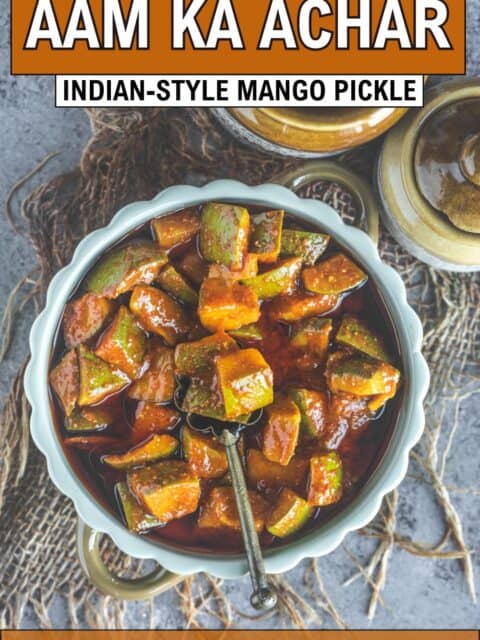
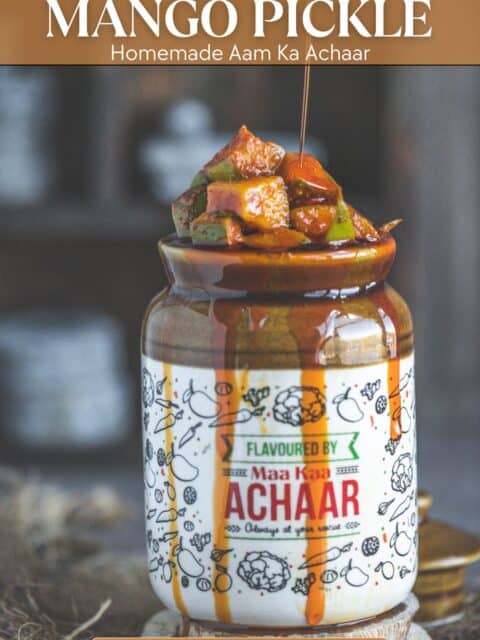
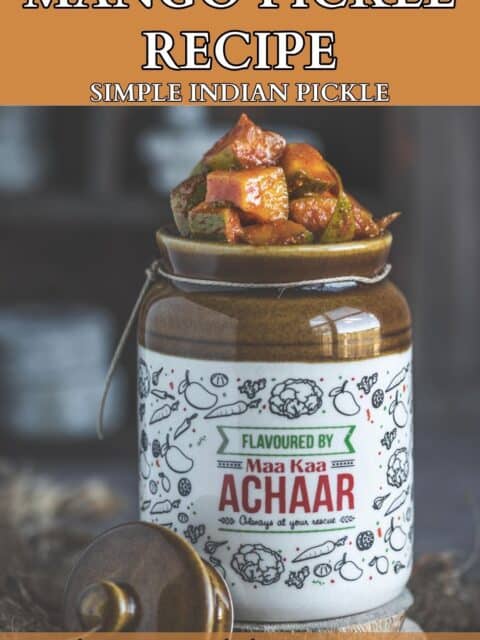
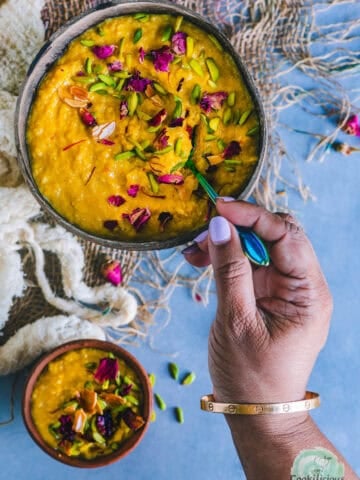
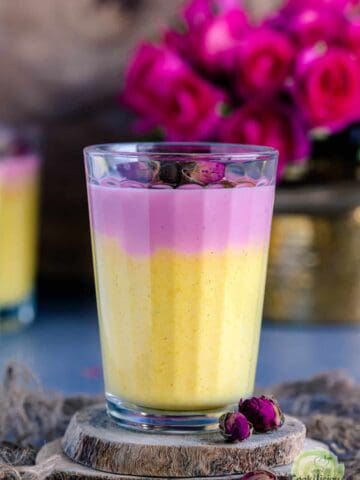
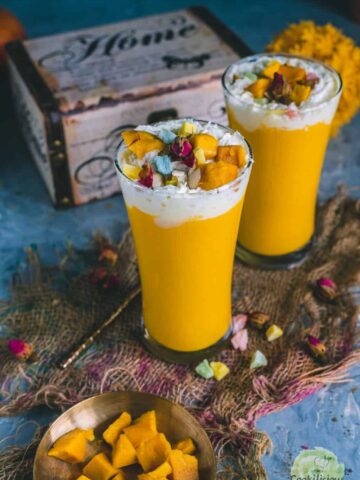
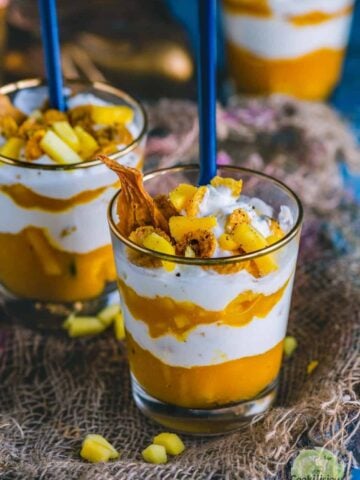
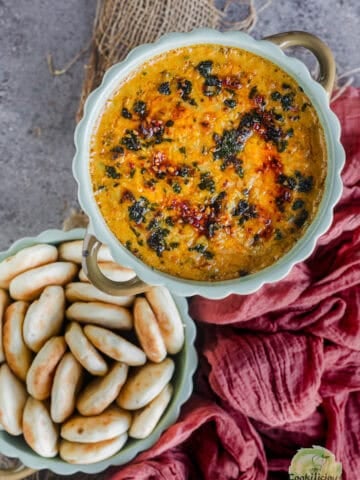
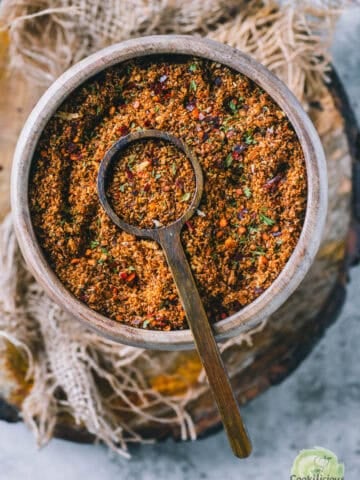

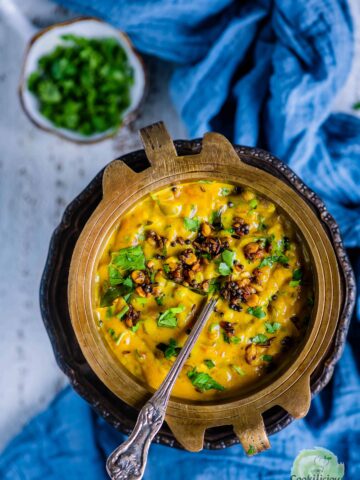
Pravin says
Just too good